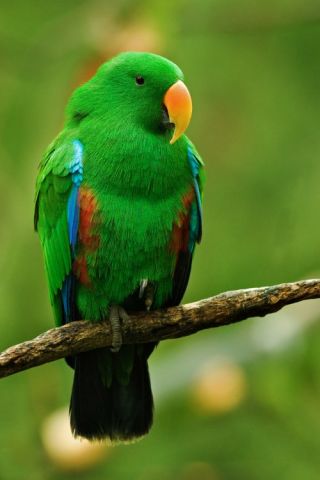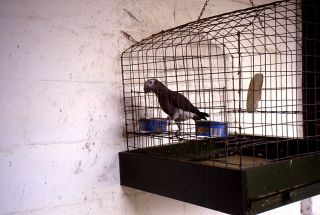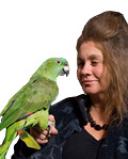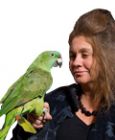Loneliness
Empty Incubation
Captive bird breeding is a never-ending spiral into despair and death.
Posted December 20, 2014
I, a stranger and afraid, in a world I never made. – A.E Housman

I, a stranger and afraid, in a world I never made. – A.E Housman
She lived alone. Days passed, dry brittle pages turned one by one, an interminable progression toward an inevitable end. Time and deaths had worn her grey. “A child,” she thought, “That’s what I need to cheer things up.” But her children were grown and her grandchildren never visited. Then, one afternoon, walking home after desultory shopping, she passed a pet store. There in the window sat a beautiful young green parrot.
His wing feathers shone a rainbow of green, red, and blue and his eyes were bright and alive. The woman pushed open the store door and walked over to the bird’s cage. “How much is that parrot?” she asked the clerk. The young man looked up and called out,”Eighty dollars without the cage, and a hundred with.” The woman opened her purse, counted out the money, and in a few moments, encaged bird in hand, was on her way home to a third-floor flat.
The bird’s chirps and snippets of song were happy punctuations in an otherwise silent room. The clerk had assured her that the bird wasn’t noisy like some parrots. She decided to call him Danny. After a few days, she moved Danny’s cage over from the window to a small table next to her armchair and that is how they spent most of the day, watching television and trading treats.
This went on for several months until her son came over to move her out. The apartment manager had called several times to complain that the old woman was causing problems. She had started to leave the television on all night, blasting, and then, caught the kitchen on fire because she had forgotten to turn off the stove. “Yesterday was the last straw,” the manager told the son. “When your mother went downstairs to take out the rubbish, she wasn’t wearing a thing. You know, we can’t have that sort of thing around here.” The doctor confirmed a diagnosis of Alzheimer’s and said that the condition was accelerating. Nursing homes weren’t affordable so the son brought his mother and Danny to their home.

Things didn’t get much better. Very soon, the outer world receded. The old woman was confused. “What are those voices and where do they come from? Where am I?” she wondered. The bright little bird began to fade as well. His frantic chirps and pecks went unnoticed and the rest of the family had little interest. “Can’t we get rid of that bird?” the wife asked. “I’m tired of cleaning up the mess and your mother doesn’t even pay him attention anymore.”
The son called the pet store where the bird had been purchased, but they weren’t interested in taking him back. “Take him to the county shelter,” the clerk advised. The son put the caged bird in the backseat of the car and dropped him off at the shelter. There, the bird now sat, alone, in the same small cage. The staff tried to get him to talk, but he stayed on the perch back turned, facing the pale stucco wall. One morning, they found him lying on his side at the bottom of the cage, legs straight out, dead.
******
The story of Danny is not so different from human children today. Danny’s suffering and death, like that of children around the industrialized world, are the fruit of abuse, neglect, and indifference. Relationships are the brokers of the soul and when these lifelines are compromised, the results are devastating. This is particularly so during the vulnerable period of childhood dependence. Of course, in the case of captive birds, dependence never ceases. Forced confinement renders even the most robust into a helpless victim of others’ whims.
Neuroscience and psychology have codified this relational paradigm for describing mental development and wellbeing. In contrast to previous models, bird and human minds are understood not as isolated billiard balls bouncing off each other, but as interpenetrating fields, similar to what Buddhist teacher Thich Nhat Hanh calls “interbeing.” An individual is less an “I” than a “we,” crafted through an accumulation of relational experiences encountered in the tumble of life.
Even before birth, in the womb or egg, the nascent mind readies to receive the subtle rhythms of parent and community. Bruce Perry, a psychiatrist who specializes in child trauma, asserts: “There is no more specific 'biological' determinant than a relationship.” These scientific insights cast a harsh light on modern society.
According to moral neuropsychologist Darcia Narvaez, industrialized life radically departs from the rest of human history, much to its detriment. Dating back 250,000 years, when our species lived in small bands as subsistence gatherers, relational rearing was positive, loving, and nurturing. Not so now. The brains of today’s children are denied this ancestral promise.
Most childhood experience is dominated by violence, abuse, indifference, and social isolation. These conditions are the underlying cause for widespread symptoms of self-injury, depression, anxiety, and bullying and they are not easy to extinguish. The mismatch between what the brain anticipates evolutionarily and what it ends up experiencing transmits across generations. Perry refers to this intergenerational enculturation as the transformation of psychological states into psychological traits. Lessons from our own species apply to others.
Bird captivity and captive breeding reflect the same imprisoning mentality that modern humans have imposed on tribal people everywhere. Epidemic suicide and despair are the signatures of colonial violence. Captive bred parrots are also denied their native heritage and biological parenting in the open expanse of freedom. They are exposed to a succession of relational shortfalls and trauma. Deprivations on the outside – unnatural rearing, premature weaning, poor nutrition, and the bone penetrating ache of loneliness – transmit within to the depth of genes. Telomeres (protective ends of a chromosome) of African Grey Parrots who live alone are shorter than those of parrots who are pair housed. The stress of loneliness foreshortens both present and future.

With every generational iteration, the natural constellation of a parrot’s mind ratchets down yet another notch. These winged souls are pulled further down into a Dante’s inferno of sterile, empty cages. Humanity’s own anguish inoculates bird minds until the figure who remains is literally parrot in form alone.
Like the lonely woman who purchased Danny, other people yearn to possess what they have lost or never had – the bright vitality of love. In so doing, millions upon millions of angels like Danny are sacrificed on the barren rocks of human pain, the echoes of loneliness piercing their hearts unto death.
References Cited
Aydinonat D, Penn DJ, Smith S, Moodley Y, Hoelzl F, et al. (2014) Social isolation shortens telomeres in African Grey Parrots (Psittacus erithacus erithacus). PLoS ONE 9(4): e93839. doi:10.1371/journal.pone.0093839
Narvaez, D. 2013. The 99 percent—development and socialization within an evolutionary context: growing up to become “a good and useful human being, In War, Peace, and Human Nature: The Convergence of Evolutionary and Cultural Views (Ed. D.P. Fry). Oxford University Press.
Perry, B.D. 1997. Incubated in terror: neurodevelopmental factors in the ‘cycle of violence.’ In: Children, Youth and Violence: The Search for Solutions (J. Osofsky, Ed.). Guilford Press, New York, pp 124- 148.




